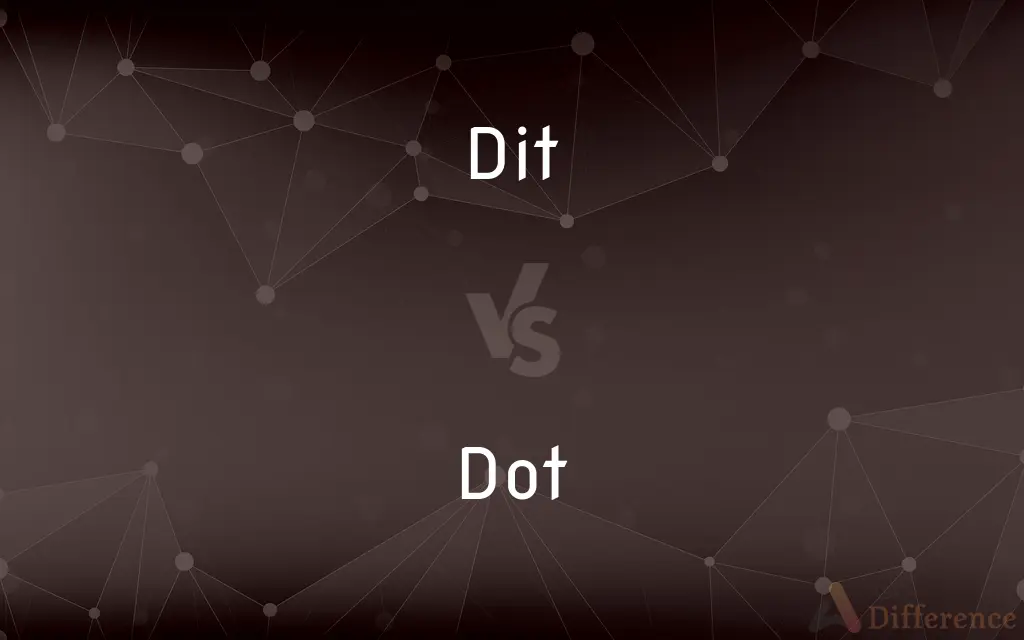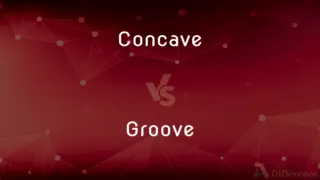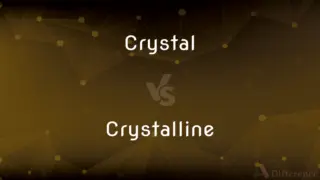Dit vs. Dot — What's the Difference?
By Fiza Rafique & Urooj Arif — Updated on April 21, 2024
A dit is a short signal in Morse code, equivalent to a dot, used to represent the letter 'E', while a dot is a small round mark used in various contexts.

Difference Between Dit and Dot
Table of Contents
ADVERTISEMENT
Key Differences
In Morse code, a dit represents the shortest sound or signal, used specifically to denote the letter 'E', which is the most common letter in English. On the other hand, a dot is a general term for any small, round mark used in writing, printing, and various forms of notation.
Dits are fundamental in Morse code communication, where timing and length of the signal are crucial; a dit is the basic unit of time in Morse code. Conversely, dots are used more broadly in everyday language and notation, such as to mark bullet points, denote periods, or serve as placeholders in documents.
The purpose of a dit is specifically communicative within the structured system of Morse code, facilitating rapid and efficient transmission of messages. Whereas, a dot can serve aesthetic, grammatical, or organizational functions, depending on its context, such as in artwork, lists, or written sentences.
Users of Morse code must learn to recognize and produce dits accurately for effective message decoding and sending. In contrast, the use of dots is learned informally and universally understood, requiring no special training or knowledge.
While the dit as a Morse code element is crucial for operators in certain professions, such as maritime or aviation communications, dots are ubiquitous in various fields and everyday life, highlighting their versatility and fundamental nature in written communication.
ADVERTISEMENT
Comparison Chart
Definition
Shortest Morse code signal for 'E'
Small, round mark in various uses
Use in Communication
Specific to Morse code
Broad, including writing and printing
Importance
Essential for Morse code efficiency
Versatile in general communication
Learning Required
Yes, for Morse code operators
No, universally recognized
Contextual Use
Professional communication in Morse
Widespread in everyday applications
Compare with Definitions
Dit
Essential for concise Morse code transmissions.
Dits are used to ensure messages are sent quickly and efficiently.
Dot
A small round mark used in writing and printing.
She dotted her 'i's with little hearts.
Dit
The shortest sound in Morse code, representing the letter 'E'.
In Morse code training, beginners learn the dit as their first signal.
Dot
Serves as a bullet point in lists.
Use dots to organize items in your shopping list.
Dit
A basic unit of time in Morse code.
The duration of a dah is three times that of a dit.
Dot
Decorative element in artwork.
The artist used dots to create texture in his painting.
Dit
Morse code element for rapid communication.
Operators must master dits to effectively communicate in Morse.
Dot
Used to denote the end of a sentence or abbreviation.
Make sure to put a dot at the end of each sentence.
Dit
A signal used in timed Morse code communication.
He sent a series of dits and dahs to spell out his message.
Dot
Acts as a placeholder in documents.
Enter your name where the dot is shown.
Dit
The spoken representation of the dot in radio and telegraph code.
Dot
A small round mark or spot
A symbol depicted in coloured dots
Dit
(obsolete) To close up.
Dot
A dowry from which only the interest or annual income was available to the husband.
Dit
A ditty, a little melody.
Dot
Mark with a small spot or spots
Wet spots of rain began to dot his shirt
Dit
(obsolete) A word; a decree.
Dot
Hit (someone)
‘You want to dot him one,’ he said
Dit
The spoken representation of a dot in radio and telegraph Morse code.
Dot
A tiny round mark made by or as if by a pointed instrument; a spot.
Dit
(information theory) decimal digit
Dot
Such a mark used in orthography, as above an i.
Dit
Indicator of a declared surname originating from Canadian French.
Dot
The basic unit of composition for an image produced by a device that prints text or graphics on paper
A resolution of 900 dots per inch.
Dit
A word; a decree.
Dot
A tiny amount.
Dit
A ditty; a song.
Dot
In Morse and similar codes, the short sound or signal used in combination with the dash and silent intervals to represent letters, numbers, or punctuation.
Dit
To close up.
Dot
A decimal point.
Dit
The shorter of the two telegraphic signals used in Morse code
Dot
A symbol (·) indicating multiplication, as in 2 · 4 = 8.
Dot
(Music) A mark after a note indicating an increase in time value by half.
Dot
(Computers) A period, as used as in URLs and email addresses, to separate strings of words, as in www.hmhco.com.
Dot
A woman's marriage portion; a dowry.
Dot
To mark with a dot.
Dot
To form or make with dots.
Dot
To cover with or as if with dots
"Campfires, like red, peculiar blossoms, dotted the night" (Stephen Crane).
Dot
To make a dot.
Dot
A small, round spot.
A dot of colour
Dot
(grammar) A punctuation mark used to indicate the end of a sentence or an abbreviated part of a word; a full stop; a period.
Dot
A point used as a diacritical mark above or below various letters of the Latin script, as in Ȧ, Ạ, Ḅ, Ḃ, Ċ.
Dot
(mathematics) A symbol used for separating the fractional part of a decimal number from the whole part, for indicating multiplication or a scalar product, or for various other purposes.
Dot
One of the two symbols used in Morse code.
Dot
(obsolete) A lump or clot.
Dot
Anything small and like a speck comparatively; a small portion or specimen.
A dot of a child
Dot
A dot ball.
Dot
(MLE) buckshot, projectile from a "dotty" or shotgun
Dot
(MLE) dotty
Dot
A dowry.
Dot
(transitive) To cover with small spots (of some liquid).
His jacket was dotted with splashes of paint.
Dot
(transitive) To add a dot (the symbol) or dots to.
Dot your is and cross your ts.
Dot
To mark by means of dots or small spots.
To dot a line
Dot
To mark or diversify with small detached objects.
To dot a landscape with cottages
Dot
(colloquial) To punch (a person).
Dot
Dot product of the previous vector and the following vector.
The work is equal to F dot Δx.
Dot
A marriage portion; dowry.
Dot
A small point or spot, made with a pen or other pointed instrument; a speck, or small mark.
Dot
Anything small and like a speck comparatively; a small portion or specimen; as, a dot of a child.
Dot
To mark with dots or small spots; as, to dot a line.
Dot
To mark or diversify with small detached objects; as, a landscape dotted with cottages.
Dot
To make dots or specks.
Dot
The United States Department of Transportation.
Dot
A very small circular shape;
A row of points
Draw lines between the dots
Dot
The United States federal department that institutes and coordinates national transportation programs; created in 1966
Dot
The shorter of the two telegraphic signals used in Morse code
Dot
Street name for lysergic acid diethylamide
Dot
Scatter or intersperse like dots or studs;
Hills constellated with lights
Dot
Distribute loosely;
He scattered gun powder under the wagon
Dot
Make a dot or dots
Dot
Mark with a dot;
Dot your `i's
Common Curiosities
How does one learn to use dits effectively?
Learning to use dits effectively requires training in Morse code, often necessary for professional communication in fields like aviation or maritime.
What are common uses for dots?
Dots are used to mark periods at the end of sentences, as bullet points in lists, and as placeholders or decorative elements.
Is a dit longer than a dot?
In Morse code, a dit is the shortest signal, while in general usage, the size of a dot can vary based on its application.
Are dits still relevant in modern communication?
Dits remain relevant in specific professional and emergency communication scenarios where Morse code is used.
What is the main difference between a dit and a dot?
A dit is a specific Morse code signal for the letter 'E', while a dot is a general mark used in various written and printed contexts.
Where is a dit used?
A dit is used in Morse code to represent the letter 'E'.
How is a dot created in writing?
A dot is typically made with a pen or pencil by pressing briefly on the paper to create a small round mark.
Can dots have different meanings based on context?
Yes, dots can have various meanings depending on their context, such as grammatical functions in writing or aesthetic purposes in art.
Why is the dit important in Morse code?
The dit is important in Morse code because it serves as the fundamental unit of time and represents the most frequently used letter, 'E'.
Do dots play a role in digital formatting?
Yes, dots are used in digital formatting for various purposes, including as bullet points in presentations and documents, or in user interfaces to indicate ongoing processes.
Share Your Discovery

Previous Comparison
Concave vs. Groove
Next Comparison
Crystal vs. CrystallineAuthor Spotlight
Written by
Fiza RafiqueFiza Rafique is a skilled content writer at AskDifference.com, where she meticulously refines and enhances written pieces. Drawing from her vast editorial expertise, Fiza ensures clarity, accuracy, and precision in every article. Passionate about language, she continually seeks to elevate the quality of content for readers worldwide.
Co-written by
Urooj ArifUrooj is a skilled content writer at Ask Difference, known for her exceptional ability to simplify complex topics into engaging and informative content. With a passion for research and a flair for clear, concise writing, she consistently delivers articles that resonate with our diverse audience.
















































